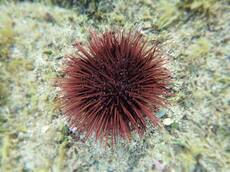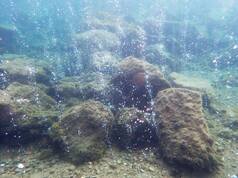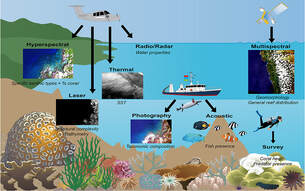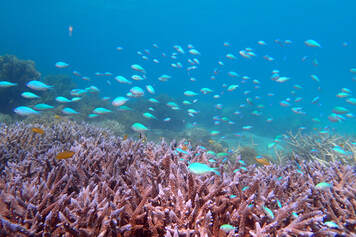Research Areas
Impacts of global climate change stressors on marine biota

Investigating whether marine species are able to phenotypically adjust, or evolutionarily adapt to a changing climate. Some marine organisms are incredibly robust to climate stress, and I'm keen to understand why! In the lab, I have tested the impacts of a variety of stressors (increased temperature, low pH, decreased salinity) on the developmental stages of a variety of marine organisms.
Related research:
Related research:
- Surviving the Anthropocene: The resilience of marine organisms to climate change. (Book chapter available soon!)
- Phenotypic plasticity in egg and jelly coat contribution to target size for sperm: A review for the Echinodermata.
- Marine gametes in a changing ocean: Impacts of climate change stressors on fecundity and the egg.
- Paternal identity influences response of Acanthaster planci embryos to ocean acidification and warming.
- Adaptive capacity of the sea urchin Heliocidaris erythrogramma to ocean change stressors: transgenerational responses from gamete performance to the juvenile.
- Contributions of genetic and environmental variance in early development of the Antarctic sea urchin Sterechinus neumayeri in response to increased ocean temperature and acidification.
- Acclimatization and adaptive capacity of marine species in a changing ocean.
- Increased temperature, but not acidification, enhances fertilization success and development in a tropical urchin: potential for adaptation to a tropicalized eastern Australia.
- Adaptive capacity of the habitat modifying sea urchin Centrostephanus rodgersii to ocean warming and ocean acidification: Performance of early embryos.
How exposure to environmental extremes influences animal response to stressors

Investigations of transgenerational and environmental effects in buffering the progeny’s response to climate change using natural model systems. Studying the adaptations animals' use to survive in extreme environments, such as natural CO2 vents which are low pH environments, can provide insight into factors that increase resilience under climate change.
Related research:
- Acclimation to low pH does not affect the thermal tolerance of the sea urchin Arbacia lixula
- Forecasting impacts of ocean acidification on marine communities: Utilising natural CO2 vents as natural laboratories
- Contrasting responses of sea urchin larvae to field and laboratory acidification
- Limitation of cross and multigenerational plasticity for marine invertebrates faced with global climate change
- The carbon dioxide vents of Ischia, Italy, a natural laboratory to assess impacts of ocean acidification on marine ecosystems: an overview of research and comparisons with other vent systems
- Residing at low pH matters, resilience of the egg jelly coat of sea urchins living at a CO2 vent site
- Effects of elevated pCO2 and the effect of parent acclimation on development in the tropical Pacific sea urchin Echinometra mathaei
Using technology to improve our understanding of coral reefs & reef restoration

- Integrating remote sensing technologies with in-water surveys and knowledge of species biology, allow an investigation of processes across much larger scales. With more and more freely available remotely sensed data and advances in technology, we can explore much more of the ocean.
Related research:
- Mapped coral mortality and refugia in an archipelago-scale marine heat wave
- Upscaling reef fish surveys using high-resolution mapping and analysis
- Impacts of remotely sensed environmental drivers on coral outplant survival
- Abiotic and human drivers of reef habitat complexity throughout the Main Hawaiian Islands
- Coral bleaching detection in the Hawaiian Islands using spatio-temporal standardized bottom reflectance and Planet Dove satellites
- Impacts of pollution, fishing pressure, and reef rugosity on resource fish biomass in West Hawai‘i
- Sea surface temperature and coral reef restoration outcomes
- Scaling up coral reef restoration using remote sensing technology
Drivers of coral reef health

The worldwide loss of live coral cover and phase shifts from coral- to algal-dominated reefs has sparked various efforts to facilitate coral reef persistence and resilience, where various human and abiotic drivers can impact reef health. Additionally, coral reefs receive input from many land based factors, connecting land-sea management will more efficiently build resilience within and between these habitats.
Related research:
- Impacts of climate change stressors on the Great Barrier Reef Oceanographic processes of coral reefs: physical and biological links in the Great Barrier Reef (book chapter available soon!)
- Untapped policy avenues to protect coral reef ecosystems
- Warming alters the relationship between benthic cover and herbivores on Hawaiian reefs
- Depth-dependent indicators of algal turf herbivory throughout the Main Hawaiian Islands
- Algal turf herbivory by water depth throughout the Main Hawaiian Islands
- Synergistic benefits of conserving land-sea ecosystems
- Drivers of reef habitat complexity throughout the Main Hawaiian Islands
